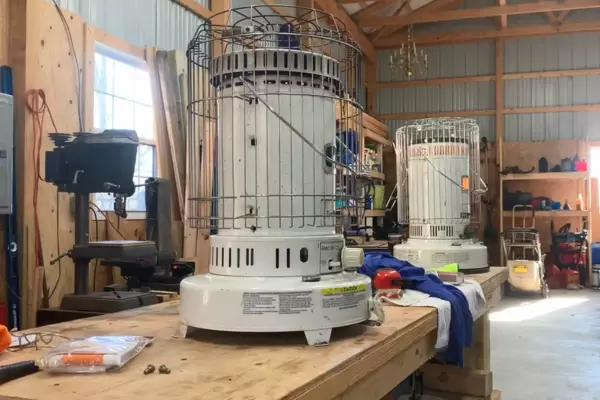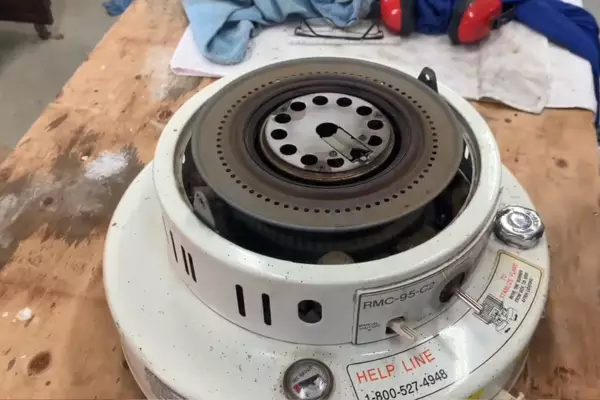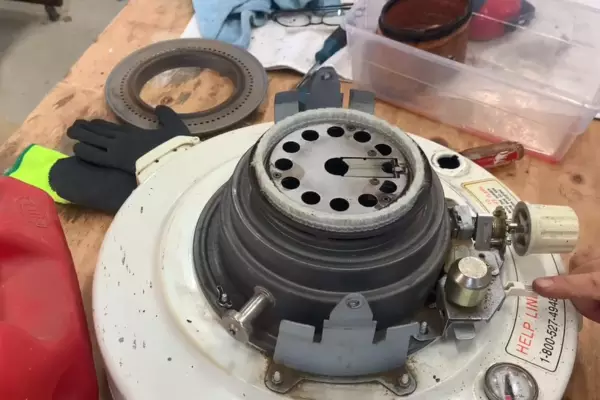A well-functioning kerosene heater can be a reliable source of heat, particularly during colder months. However, the experience can quickly turn worrisome if your heater begins to emit black smoke. This issue is not only problematic for your indoor air quality, but it also points to underlying faults in your heater’s operation.
The presence of black smoke from a kerosene heater generally indicates improper combustion. It could result from a range of factors like the quality of kerosene used, incorrect wick height, or inadequate maintenance. These elements need to be analyzed and addressed to prevent further complications.
While kerosene heaters are a popular heating option, improper use can lead to troublesome and sometimes hazardous situations. The appearance of black smoke is a sign that your heater needs immediate attention.
Contents
Common Reasons for Black Smoke
Black smoke from a kerosene heater is primarily a byproduct of improper combustion. When the heater doesn’t burn the fuel completely, it can release carbon particles into the air, leading to black smoke. Several factors can cause this issue:
Poor Quality Kerosene
Low-quality or contaminated kerosene burns inefficiently, leading to incomplete combustion and increased smoke. For example, 2-K grade kerosene, typically used in lamps and stoves, may contain more sulfur and impurities compared to the 1-K grade, making it unsuitable for indoor heaters.

Misaligned or Overly Saturated Wick
The wick serves as the fuel supply route to the burner. An incorrect wick height can disrupt the fuel supply, leading to incomplete combustion and black smoke. Similarly, an overly saturated wick may deliver too much fuel to the burner, again causing inefficient burning and increased smoke.
Lack of Regular Maintenance
Failing to perform regular maintenance and cleaning can lead to a buildup of soot and carbon in the heater, disrupting the combustion process and leading to black smoke. Regularly cleaning the wick and the heater’s combustion chamber can significantly improve its performance and reduce smoke emissions.
The Influence of Kerosene Quality
Using high-quality kerosene is vital for optimal heater performance. Lower grade or contaminated kerosene often contains impurities, which can clog the wick, disrupt combustion, and lead to black smoke. It is recommended to use 1-K grade kerosene for indoor heaters, known for its low sulfur content and minimal impurities.
However, kerosene quality is not just about its grade. Even high-grade kerosene can degrade if not stored properly. Kerosene should be kept in clean, certified containers, away from direct sunlight and moisture. Using a funnel with a built-in filter when filling the heater can also help to remove any debris and ensure clean, efficient burning.
Effects of Wick Adjustment on Smoke
A correctly adjusted wick is crucial to the heater’s performance. If the wick is set too high, it could cause the kerosene to burn too quickly, leading to excessive smoke. Conversely, a wick set too low may not deliver enough fuel to the burner, causing incomplete combustion and smoke production.
The wick’s position can typically be adjusted using a knob on the heater. The optimal wick height varies between models but usually falls within 1/8 to 1/2 inch above the wick adjuster. Regularly checking and adjusting the wick height can help to maintain optimal combustion and reduce smoke emissions.
An over-saturated wick can also contribute to black smoke. This typically occurs when the heater is refilled without first extinguishing the flame, causing the wick to soak up too much kerosene. To avoid this, it is recommended to turn off the heater and let the wick dry before refilling the tank.
Importance of Heater Maintenance
Regular maintenance plays a critical role in the heater’s performance and longevity. Without proper care, soot and carbon can build up inside the heater, leading to reduced efficiency and increased smoke. Maintenance should include:
Routine Cleaning
This involves removing soot buildup from the wick and combustion chamber, cleaning the fuel tank to remove any debris, and wiping down the heater’s exterior. It’s advisable to perform cleaning after every few uses to keep the heater running efficiently.
Component Inspection and Replacement
Over time, parts like the wick and igniter may wear out and need to be replaced. Regularly inspect these components and replace them as needed. A damaged or worn-out wick can disrupt fuel supply and combustion, leading to smoke, while a faulty igniter may cause the heater to light improperly or not at all.

How Kerosene Quality Affects Heater Performance
Kerosene Grades and Their Impact
Kerosene comes in different grades, each suited to specific uses. The 1-K grade kerosene is typically recommended for indoor heaters due to its low sulfur content and minimal impurities. Using a lower-grade kerosene can lead to inefficient burning and increased smoke.
In addition, using dyed kerosene may also increase smoke emissions. Dyed kerosene usually contains higher levels of impurities, which can disrupt combustion. Therefore, it’s best to use clear, 1-K grade kerosene for your heater.
Proper Storage of Kerosene
Proper storage of kerosene is crucial to maintaining its quality. Exposure to sunlight, moisture, or contaminants can degrade kerosene, affecting its burning efficiency. To ensure your kerosene remains in top condition:
- Store kerosene in a certified, airtight container. This prevents air and moisture from getting in and keeps contaminants out.
- Keep the container in a cool, dry place, away from direct sunlight. Heat and light can speed up the degradation process, while a dry environment prevents moisture buildup.
- Never store kerosene in a container previously used for other fuels or chemicals. Residues from these substances can contaminate the kerosene and affect its burning efficiency.
Wick Adjustment: A Key Factor in Smoke Production
Correct Wick Height for Optimal Use
Maintaining the correct wick height is essential for efficient combustion and minimal smoke production. When set correctly, the wick delivers an optimal amount of kerosene to the burner, ensuring complete combustion and a steady flame.
The ideal wick height varies depending on the heater model, but it typically falls between 1/8 and 1/2 inch above the wick adjuster. If the wick is set too high, it may cause the heater to burn too much kerosene, leading to black smoke. Conversely, a wick set too low may not supply enough fuel to the burner, causing the flame to flicker or die out.
Effects of Over-saturated Wick
An over-saturated wick can disrupt combustion and contribute to smoke production. When too much kerosene is supplied to the burner, it can lead to incomplete combustion and black smoke. To prevent this, ensure the wick is not too wet before lighting the heater.
If you notice that your wick is overly saturated, turn off the heater and let the wick dry before reigniting. This allows excess kerosene to evaporate, ensuring a clean, efficient burn when you light the heater again.
Essential Maintenance for Kerosene Heaters
Routine Cleaning and Care
Regularly cleaning your kerosene heater can greatly improve its performance and lifespan. This includes cleaning the wick, combustion chamber, and fuel tank to remove soot and debris.
For optimal performance, follow these cleaning steps:
- Wick Cleaning: Remove the wick and gently clean it using a soft brush to remove soot and other residues. If the wick is heavily soiled or damaged, it may need to be replaced.
- Combustion Chamber Cleaning: Use a vacuum or brush to clean out any soot or ash from the combustion chamber. Be sure to clean the burner ring as well, as this is where most of the combustion takes place.
- Fuel Tank Cleaning: Empty the fuel tank and clean it using a damp cloth to remove any sediment or debris. This helps to ensure a clean fuel supply, leading to better combustion and less smoke.
Replacement of Old Components
Over time, certain components of your kerosene heater, like the wick and igniter, may wear out and need to be replaced. Regularly inspect these parts for signs of wear or damage, and replace them as needed. A well-maintained wick and igniter can significantly improve your heater’s performance and efficiency.
When replacing components, always use parts recommended by the heater manufacturer. This ensures a proper fit and optimal performance.

Addressing Smoke Issues: Practical Steps
How to Stop Paraffin Heater from Smoking
If your paraffin heater is producing black smoke, there are several steps you can take to remedy the problem:
- Use High-Quality Fuel: Ensure you’re using high-quality, 1-K grade kerosene. Lower grade or contaminated kerosene can burn inefficiently and produce smoke.
- Adjust the Wick: Check that the wick height is set correctly. An overly high or low wick can disrupt combustion and cause smoke.
- Perform Regular Maintenance: Regularly clean the wick and combustion chamber, and replace worn-out components as needed. Proper maintenance can greatly enhance your heater’s performance and reduce smoke emissions.
Fine-Tuning Your Kerosene Heater to Stop Smoking
Fine-tuning your kerosene heater can significantly reduce smoke emissions. Here’s how:
- Ensure Adequate Ventilation: A well-ventilated room can improve combustion efficiency and reduce smoke production. Ventilation also helps to prevent the buildup of potentially harmful gases.
- Maintain a Steady Flame: Adjust the wick to maintain a steady, blue flame. A flickering or yellow flame can indicate incomplete combustion and increased smoke.
- Regularly Inspect Components: Check for signs of damage or wear on the wick and igniter. Replace these components as needed to maintain optimal performance.
Safe Disposal of Kerosene Waste
Dispose of old or contaminated kerosene in a safe and environmentally friendly way. Many local waste disposal facilities and recycling centers accept kerosene waste. Never pour kerosene down the drain or into the soil, as it can pollute water sources and harm wildlife.
Ensuring Safe Use of Kerosene Heaters
Importance of Proper Ventilation
When using a kerosene heater, ensure the room is well-ventilated. This helps to prevent the buildup of carbon monoxide, a potentially harmful gas that can be produced during combustion. Opening a window or door can provide adequate ventilation.
Necessary Safety Precautions
Kerosene heaters can be safe and efficient heating options when used correctly. Always follow the manufacturer’s instructions and take the necessary safety precautions. This includes keeping the heater away from flammable materials, turning it off when not in use or when refilling, and using a carbon monoxide detector to ensure safe air quality.
Frequently Asked Questions
Why does my kerosene heater emit a strong odor?
A strong odor can be due to impure kerosene, a dirty wick, or inadequate ventilation.
How often should I change the wick on my kerosene heater?
It is advisable to change the wick at least once every heating season, or sooner if it appears damaged or excessively sooty.
How can I safely store unused kerosene?
Store kerosene in a tightly sealed, approved container, and keep it in a cool, dry location away from sunlight.
Conclusion
Black smoke from a kerosene heater signifies a need for immediate intervention. It’s a clear sign of an underlying problem—usually related to kerosene quality, wick adjustment, or maintenance issues.
Addressing these concerns promptly not only restores your heater’s performance but also ensures your indoor air remains clean and safe. By giving your heater the care it requires, you can enjoy the warmth it provides without the worry of black smoke.
Remember, proper use and maintenance of a kerosene heater are key to its performance. Following these guidelines will ensure your heater remains an efficient and reliable source of warmth, offering you comfort throughout the colder months.

